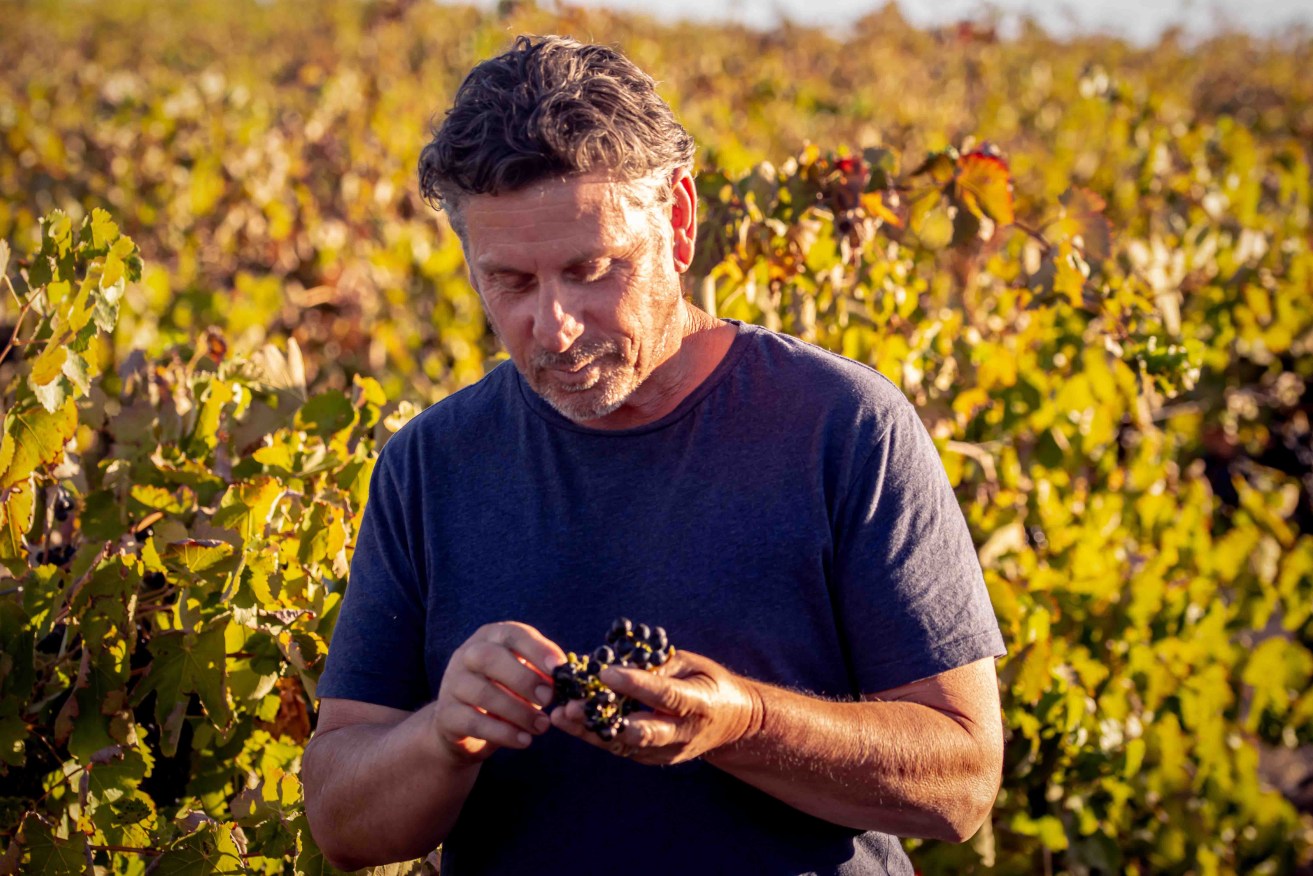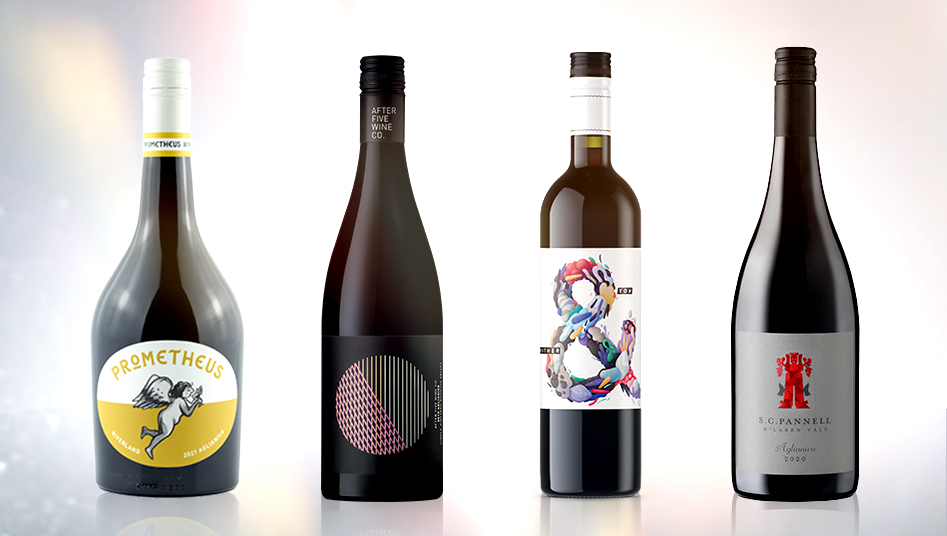Wine reviews: The Italian uber-alternative turning heads
And now for the next “alternative” variety which is having a dream run with show judges. Our wine writer unpacks why it’s garnering so much success and suggests some local bottles to try.


Craig Stansborough of Purple Hands Wines in the Barossa. Supplied image
When you start your wine alphabet engines the first thing you come across is a fast-rising red star called Aglianico, which hails originally from southern mainland Italy but has found its way here and is now grown by more than 20 South Australian producers, albeit in tiny but slowing expanding quantities. That’s not many, so we are talking extreme “Alternative” or “Emerging”.
Note quickly that as you read this, pronounce the word simply as “ally-anico” without the hard “g”. Language lesson done.
So why Aggie?
Firstly, it has plenty going for it in a grape-growing sense, as it handles our warm to sometimes hot ripening season really well, the fruit holding onto its natural acidity and therefore retaining its much- desired freshness. It is pretty frugal when it comes to water, and is one of the last to be harvested so fits very conveniently into winery operation schedules after most other varieties are done and dusted.
Most importantly, it is considered by leading experts to be one of the most significant southern Italian red varieties, and in many opinions up there with Sangiovese from Tuscany and Nebbiolo from Piedmont in terms of the leading three Italian wines of genuine finesse and quality.
We’ll leave that debate for another day, but what’s agreed is it seems to get on really well here in our climate and conditions. And the wines that are resulting have begun to garner some serious notice.
At the recent Australian Alternative Varieties Wine Show, there were just 10 entries from across the country in its varietal class. At this year’s Riverland Wine Show, there were only two entered in the “Other Italian Reds” category. From the Barossa, only one turned up to be judged, and in McLaren Vale just two in the whole show.
But out of that minor turnout, this is what happened. A wine from the Barossa – Purple Hands After Five Wine Co 2021 Aglianico – was judged best red Italian variety, best red and best wine at the AAVWS. At the McLaren Vale Wine Show, the Hither & Yon 2021 Aglianico scored the top gold medal points in its Single Mediterranean Red Varietal class and eventually rose to the top to be judged the best in show and named the Bushing Monarch wine for 2022, beating all that region’s highly regarded Shiraz, Grenache and other red varieties and blends.
Other accolades have included gold medals to Ricca Terra’s 2021 Aglianico at this year’s Riverland competition, while at last year’s AAVWS the Prometheus 2021 Aglianico scored the top gold medal in its varietal class and was also voted judges’ best red wine choice at a more informal Fiesta del Vino in the Riverland, a mini-comp of 40 odd growers tapping into Ricca Terra’s multi-varietal source vineyards.
Back in McLaren Vale, keen Aglianico adopter Stephen Pannell’s SC Pannell 2020 Aglianico was lauded in the latest Halliday Wine Companion by tasting panellist Ned Goodwin MW. The wine was placed in the top 20 other reds and blends category and summed up “as emblematic of our vinous future as Grenache, despite being a relative arriviste”. (By the way, Pannell’s Koomilya Cabernet Touriga 2018 was voted Other Red of the Year in that same list.)
So clearly there is something going on here.
It’s establishing its place in our alternative/emerging variety consciousness because a cohort of like-minded producers are championing its benefits, one-half of the Hither & Yon brothers, Malcolm Leask notes. (The other is regenerative viticulturist extraordinaire and winemaker Richard.)
“We need that band to be getting the word out,” Leask says. “And seeing it now making news in several regions helps awareness, too.”
“We were really happy when Purple Hands won with its Aglianico at the Alternatives Show with a wine from the Barossa. It was a brilliant exclamation mark to what happened at the McLaren Vale Show.”
In the Vales, also, the variety has now joined with a “like-minded” group of varieties from southern Italy – Fiano, which now has its own judging class at the regional show, and Nero d’Avola – suggesting there’s a genuine home away from home there for these “New Australians” from the Mediterranean regions. The same applies in the Riverland.
One of the main reasons it has found new and enthusiastic roots here is its adaptability to our warmer wine region climates and ripening season weather.
Purple Hands’ winemaker Craig Stansborough admits he’s a big fan of Italian wines, especially the northern regional hero Barolo from the Nebbiolo grape. Having tasted many varieties from other parts of the country, as most winemakers do on their days off, he became convinced that Aglianico was considered to be the Barolo of Southern Italy, and that was enough for him to dive more deeply.
“It looked pretty suited to our climate in the Barossa, it’s less reliant on water than many other varieties, and it holds it natural grape acidity, even in warmer years,” Stansborough explains.
And another thing that both he and Malcolm Leask note: it’s one of the latest ripening vines which means it is harvested after everything else has been picked. Logistically this is a great blessing for winery operations.
At his Williamstown vineyard, the Aglianico fruit comes in sometimes four, five or six weeks after the Shiraz that’s planted right next to it, and still is holding onto its refreshing fruit acidity.
“It’s really important, and a key driver in why we chose to plant it and why it is doing so well,” Stansborough says. “You can’t beat natural acidity for length and persistence.”
We now start to get to understand a bit more about how this particular grape brings its core varietal attributes to the tasting experience.
The acidity, as mentioned, together with the variety’s pronounced tannin profile provide a mouth feel that is quite dry in most cases. It can be quite pretty to begin, with aromas and flavours across a spectrum from cherry and subtle rose petals through to dark plum and fig, while the more savoury elements are perhaps even more defining – smoked meats sometimes, white pepper occasionally, licorice and fennel, dried herbs and cocoa powder as well.
“It can be a bit dry for some – it’s not everyone’s cup of tea,” Stansborough says. “But people are able to understand the flavour profile and the tannins.
“Once you get it, you get it. The tannins are so fine and long, it’s a real feature of the wine.”
Malcolm and Richard Leask have evolved their winemaking to seek out what they call a “tension” in their wines, this variety typical of their success. For them, this means stretching out a juicy mid-palate so the wine still has good concentration and varietal flavour, but it also finishes refreshing.
“It’s really hard to do, and can only come from a really well-balanced vineyard environment and not adding acid. It doesn’t need it, and it’s something we pride ourselves on.
“Natural acidity with flavour, fruit purity and weight. And it tastes like the Vales.”
There might be some contention here, but part of that regional flavour, Malcolm suggests, is a little bit of salinity in the wine’s flavour profile, almost like a seasoning. It most likely comes from the maritime influence of the nearby Gulf breezes, he reckons, but also an uptake of soil characters as they use less and less water, especially for a variety like Aglianico.
And one last thing, he says, about teasing out the meaning of “savoury” as a wine descriptor, which he admits he doesn’t like to use.
Instead, he prefers the term “rusticity” which he feels is a more appropriate Australian term.
“’Rusticity’ speaks to the heritage of the variety firstly,” Leask says. “But, also, the wine is not really a polished style. It tastes quite grapey; it’s very sensual and tactile to taste.
“It leaves your mouth salivating, and that’s quite often the way with good wine or food. It has texture, but not in a deep way. It has a lovely, chewy, herbaceous character, and then brings in a nice grainy, seedy, fruit tannin – that’s what’s special about it.”
It’s good to drink on its own, and it’s very food friendly.
TASTING NOTES

Prometheus Aglianico 2021
Riverland / 14% / $25
Sourced from the Ricca Terra vineyard in Barmera, and presented in a distinctive, stocky-shouldered bottle. The wine starts with the variety’s natural fragrance of dark rose and cherry and heads on down that route flavour-wise as well, quite fleshy in its feels, the palate energy driven by trademark tannins and acidity, fine, dusty and earthy texturally, and tending to a more robust style. A wine with a bit of down-home country character to it, and most welcome beside gamier meats on the barbecue.
Purple Hands After Five Wine Co Aglianico 2021
Barossa / 13% / $35
Judged best red and overall wine of show at the 2022 Australian Alternative Varieties Wine Show, there’s a lot going on in this wine as it reveals itself over time in the glass or even better, out of a decanter. It might feel a little muscly to start, with a distinctive varietal take on what that might usually mean in a Barossan context. Dark rose and earthy notes begin the story – characters common to many other Aggies – but here also with sprinklings of red licorice, herb garden fragrances and white pepper as you taste. Then those much-awaited varietal tannins come into play, a fine, long-lasting line to them offset and interplayed with vibrant acidity that also is a regular aspect in the grape. A handsome style. Try also a sibling Purple Hands After Wine Co Serata (2021) which goes the whole Barossa mile as a single vineyard blend of Shiraz (41%), Montepulciano (39%) and Aglianico (20%).
Hither & Yon Aglianico 2021
McLaren Vale / 14% (cork) / $36
This year’s “Bushing Monarch” at the McLaren Vale Wine Show – in other words judged the best wine of show. This is the 10th vintage the Brothers Leask have produced the variety. They now lean to a slightly fresher feel than others in this field, so the fragrance suggests crushed red berry and mid-crimson rose petal, rather than darker fruit and flower notes. Then follows a deliciously even palate flow which revels in its backbone of natural acidity and trademark fine, chalk-dusty and earthy tannin-coated mouth feels. Give this a heap of time in a jug or decanter if you plan to serve it for dinner – I tasted this over several days and it graduated impressively in complexity and moreishness. A wine that grows on you and is very food compatible, arguably food-enhancing. Try also the H&Y Aglianico Rose 2022 which presents a lively mix of red cherry, watermelon and faintly tonic bitters – and is brilliantly refreshing.
SC Pannell Aglianico 2020
McLaren Vale / 14% / $42
Stephen Pannell is a keen devotee of the variety, an avowed fan of wines with tannin and texture, which comes easily to Aglianico in the Vales, and, seemingly, in other warmer regional environments. Savoury to the hilt, earthy and almost clay and sand-like in how it hits your senses, fennel, maybe a touch of salty licorice all play their part, yet with glimpses of darker cherry and black-skinned plum as well. Tannins of course flow evenly and supportively. It begs for a colourful, vegie-laden North African style tagine.




